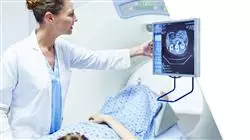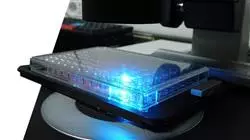University certificate
The world's largest faculty of nursing”
Introduction to the Program
Join now to master the techniques of radiological intervention in just 6 weeks and online”

Biomedical imaging is the innovative alternative to surgical intervention. Their processes are diverse depending on the pathology in which they are applied and are an advantage in clinical applications and biomedicine. This program delves in detail into each of the techniques and procedures related to medical imaging tests, such as image-guided interventionism, nuclear medicine and ultrasound, among many other concepts.
This Postgraduate certificate has been consciously designed to educate health care specialists with a future vision towards medical care and to meet the current demands of the sector. In this line, public and private companies opt for professionals who are updated in new tools, such as computed tomography. Therefore, it is essential that those who want to work in this area or are already working in it, decide to expand and update their knowledge. This is TECH’s goal, through a 100% online modality, so that studying this program does not require students to disregard other areas of their private and professional lives.
TECH proposes a theoretical-practical program in which the simulation of real cases taught by teachers based in Radiology and Biomedicine stand out. In this way, students will have the guidance of professionals with whom they will be able to contact through a direct communication channel. All this, so that the specialist is introduced to new areas, such as nuclear medicine and radiotracer tracking, and also to the way in which these tools can continue to evolve in the future.
Be part of the clinical evolution, becoming an expert in the E-Health field and mastering the tools for intervention with biomedical imaging”
This Postgraduate certificate in Biomedical Imaging Techniques and Intervention in E-Health contains the most complete and up-to-date scientific program on the market. The most important features include:
- The development of case studies presented by experts in Recognition and Intervention Techniques
- The graphic, schematic, and practical contents with which they are created, provide scientific and practical information on the disciplines that are essential for professional practice
- The practical exercises where the self-evaluation process can be carried out to improve learning
- Its special emphasis on innovative methodologies
- Theoretical lessons, questions to the expert, debate forums on controversial topics, and individual reflection assignments
- Content that is accessible from any fixed or portable device with an Internet connection
PET has succeeded in reducing invasive interventions and in identifying technological alternatives to surgery in critically ill patients. Enter now into the future of medicine thanks to the syllabus of this program"
The program’s teaching staff includes professionals from the sector who contribute their work experience to this educational program, as well as renowned specialists from leading societies and prestigious universities.
Its multimedia content, developed with the latest educational technology, will allow the professional a situated and contextual learning, that is, a simulated environment that will provide an immersive training programmed to train in real situations.
The design of this program focuses on Problem-Based Learning, in which the professional will have to try to solve the different professional practice situations that will arise throughout the academic course. This will be done with the help of an innovative system of interactive videos made by renowned experts.
It delves into the regulatory aspects and rules of telemedicine to understand the importance of acting under health ethics"

Computerized Tomography has opened up a range of possibilities in the clinical interventions. Learn about the latest developments with TECH"
Why study at TECH?
TECH is the world’s largest online university. With an impressive catalog of more than 14,000 university programs available in 11 languages, it is positioned as a leader in employability, with a 99% job placement rate. In addition, it relies on an enormous faculty of more than 6,000 professors of the highest international renown.

Study at the world's largest online university and guarantee your professional success. The future starts at TECH”
The world’s best online university according to FORBES
The prestigious Forbes magazine, specialized in business and finance, has highlighted TECH as “the world's best online university” This is what they have recently stated in an article in their digital edition in which they echo the success story of this institution, “thanks to the academic offer it provides, the selection of its teaching staff, and an innovative learning method aimed at educating the professionals of the future”
A revolutionary study method, a cutting-edge faculty and a practical focus: the key to TECH's success.
The most complete study plans on the university scene
TECH offers the most complete study plans on the university scene, with syllabuses that cover fundamental concepts and, at the same time, the main scientific advances in their specific scientific areas. In addition, these programs are continuously being updated to guarantee students the academic vanguard and the most in-demand professional skills. In this way, the university's qualifications provide its graduates with a significant advantage to propel their careers to success.
TECH offers the most comprehensive and intensive study plans on the current university scene.
A world-class teaching staff
TECH's teaching staff is made up of more than 6,000 professors with the highest international recognition. Professors, researchers and top executives of multinational companies, including Isaiah Covington, performance coach of the Boston Celtics; Magda Romanska, principal investigator at Harvard MetaLAB; Ignacio Wistumba, chairman of the department of translational molecular pathology at MD Anderson Cancer Center; and D.W. Pine, creative director of TIME magazine, among others.
Internationally renowned experts, specialized in different branches of Health, Technology, Communication and Business, form part of the TECH faculty.
A unique learning method
TECH is the first university to use Relearning in all its programs. It is the best online learning methodology, accredited with international teaching quality certifications, provided by prestigious educational agencies. In addition, this disruptive educational model is complemented with the “Case Method”, thereby setting up a unique online teaching strategy. Innovative teaching resources are also implemented, including detailed videos, infographics and interactive summaries.
TECH combines Relearning and the Case Method in all its university programs to guarantee excellent theoretical and practical learning, studying whenever and wherever you want.
The world's largest online university
TECH is the world’s largest online university. We are the largest educational institution, with the best and widest online educational catalog, one hundred percent online and covering the vast majority of areas of knowledge. We offer a large selection of our own degrees and accredited online undergraduate and postgraduate degrees. In total, more than 14,000 university degrees, in eleven different languages, make us the largest educational largest in the world.
TECH has the world's most extensive catalog of academic and official programs, available in more than 11 languages.
Google Premier Partner
The American technology giant has awarded TECH the Google Google Premier Partner badge. This award, which is only available to 3% of the world's companies, highlights the efficient, flexible and tailored experience that this university provides to students. The recognition as a Google Premier Partner not only accredits the maximum rigor, performance and investment in TECH's digital infrastructures, but also places this university as one of the world's leading technology companies.
Google has positioned TECH in the top 3% of the world's most important technology companies by awarding it its Google Premier Partner badge.
The official online university of the NBA
TECH is the official online university of the NBA. Thanks to our agreement with the biggest league in basketball, we offer our students exclusive university programs, as well as a wide variety of educational resources focused on the business of the league and other areas of the sports industry. Each program is made up of a uniquely designed syllabus and features exceptional guest hosts: professionals with a distinguished sports background who will offer their expertise on the most relevant topics.
TECH has been selected by the NBA, the world's top basketball league, as its official online university.
The top-rated university by its students
Students have positioned TECH as the world's top-rated university on the main review websites, with a highest rating of 4.9 out of 5, obtained from more than 1,000 reviews. These results consolidate TECH as the benchmark university institution at an international level, reflecting the excellence and positive impact of its educational model.” reflecting the excellence and positive impact of its educational model.”
TECH is the world’s top-rated university by its students.
Leaders in employability
TECH has managed to become the leading university in employability. 99% of its students obtain jobs in the academic field they have studied, within one year of completing any of the university's programs. A similar number achieve immediate career enhancement. All this thanks to a study methodology that bases its effectiveness on the acquisition of practical skills, which are absolutely necessary for professional development.
99% of TECH graduates find a job within a year of completing their studies.
Postgraduate Certificate in Biomedical Imaging Techniques and Intervention in E-Health
Biomedical imaging is an increasingly important tool in clinical practice, as it allows the visualization of internal structures of the human body in a non-invasive way. TECH's Postgraduate certificate in Biomedical Imaging Techniques and Intervention through Biomedical Imaging in E-Health is designed to train nursing professionals in the use of these techniques in the clinical setting. The program focuses on advanced techniques such as computed tomography, magnetic resonance imaging, nuclear medicine and image-guided interventionalism, and provides comprehensive and rigorous training in these areas.
Orient your professional career towards Intervention with Biomedical Imaging
Throughout this 100% online Postgraduate certificate, you will delve into the principles of operation of the different techniques of Biomedical Imaging, image-guided interventionism and the creation of 3D images. In addition, you will have a prestigious and experienced teaching team in the field of biomedical imaging, which will guide you in acquiring the necessary knowledge for the application of these techniques in clinical practice.







